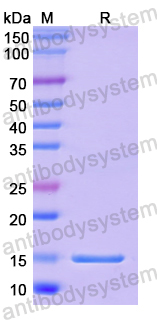Catalog No.
YHF49401
Expression system
E. coli
Species
Homo sapiens (Human)
Protein length
Asn26-Thr133
Predicted molecular weight
13.80 kDa
Nature
Recombinant
Endotoxin level
Please contact with the lab for this information.
Purity
>90% as determined by SDS-PAGE.
Accession
P62263
Applications
ELISA, Immunogen, SDS-PAGE, WB, Bioactivity testing in progress
Form
Lyophilized
Storage buffer
Lyophilized from a solution in PBS pH 7.4, 0.02% NLS, 1mM EDTA, 4% Trehalose, 1% Mannitol.
Reconstitution
Reconstitute in sterile water for a stock solution. A copy of datasheet will be provided with the products, please refer to it for details.
Shipping
In general, proteins are provided as lyophilized powder/frozen liquid. They are shipped out with dry ice/blue ice unless customers require otherwise.
Stability and Storage
Use a manual defrost freezer and avoid repeated freeze thaw cycles. Store at 2 to 8°C for frequent use. Store at -20 to -80°C for twelve months from the date of receipt.
Alternative Names
RPS14, Small ribosomal subunit protein uS11, 40S ribosomal protein S14
Fusobacterium nucleatum promotes colorectal cancer through neogenesis of tumor stem cells., PMID:39656543
Genome-wide functional integration identified MAZ-controlled RPS14 dysregulation in hepatocellular carcinoma., PMID:38189915
The Key Role of the RPS14 Gene in Neoplasms and Solid Tumors., PMID:37665724
miR-146b-5p promotes duck Tembusu virus replication by targeting RPS14., PMID:37441905
Rps14 upregulation promotes inner ear progenitor proliferation and hair cell regeneration in the neonatal mouse cochlea., PMID:36977657
CircZSWIM6 mediates dysregulation of ECM and energy homeostasis in ageing chondrocytes through RPS14 post-translational modification., PMID:36604982
RPS14 promotes the development and progression of glioma via p53 signaling pathway., PMID:36535509
Identification of Key Genes and Pathways Involved in Circulating Tumor Cells in Colorectal Cancer., PMID:35127345
Preparation of ribosomal protein S14 polyclonal antibody in broiler pulmonary artery: Its application in broiler ascites syndrome., PMID:34699893
The important role of RPS14, RPL5 and MDM2 in TP53-associated ribosome stress in mycophenolic acid-induced microtia., PMID:34537545
Downregulation of RPS14 inhibits the proliferation and metastasis of estrogen receptor-positive breast cancer cells., PMID:34261921
Evolution of Ribosomal Protein S14 Demonstrated by the Reconstruction of Chimeric Ribosomes in Bacillus subtilis., PMID:33649148
Identification of ribosomal protein family in triple-negative breast cancer by bioinformatics analysis., PMID:33305312
FANCA, TP53, and del(5q)/RPS14 alterations in a patient with T-cell non-Hodgkin lymphoma and concomitant Fanconi anemia and Li-Fraumeni syndrome., PMID:33183999
The effect of miR-223 on cellular behaviour in non-5q myelodysplastic syndromes through targeting RPS14., PMID:32571542
Pan-Proteomic Analysis and Elucidation of Protein Abundance among the Closely Related Brucella Species, Brucella abortus and Brucella melitensis., PMID:32486122
Integrated analyses of translatome and proteome identify the rules of translation selectivity in RPS14-deficient cells., PMID:32327500
ClpP participates in stress tolerance, biofilm formation, antimicrobial tolerance, and virulence of Enterococcus faecalis., PMID:32033530
MMP9 inhibition increases erythropoiesis in RPS14-deficient del(5q) MDS models through suppression of TGF-β pathways., PMID:31540902
The Response of Haloferax volcanii to Salt and Temperature Stress: A Proteome Study by Label-Free Mass Spectrometry., PMID:31502396
Stable native RIP9 complexes associate with C-to-U RNA editing activity, PPRs, RIPs, OZ1, ORRM1 and ISE2., PMID:31077462
Ribosomal protein RPL22/eL22 regulates the cell cycle by acting as an inhibitor of the CDK4-cyclin D complex., PMID:30874462
Ribosomal Proteins Control Tumor Suppressor Pathways in Response to Nucleolar Stress., PMID:30706966
Rps14, Csnk1a1 and miRNA145/miRNA146a deficiency cooperate in the clinical phenotype and activation of the innate immune system in the 5q- syndrome., PMID:30651631
MALDI-TOF Characterization of Protein Expression Mutation During Morphological Changes of Bacteria Under the Impact of Antibiotics., PMID:30628781
Molecular pathogenesis of myelodysplastic syndromes with deletion 5q., PMID:30578738
Senescence-associated ribosome biogenesis defects contributes to cell cycle arrest through the Rb pathway., PMID:29941930
L-leucine increases translation of RPS14 and LARP1 in erythroblasts from del(5q) myelodysplastic syndrome patients., PMID:29903759
ECD1 functions as an RNA-editing trans-factor of rps14-149 in plastids and is required for early chloroplast development in seedlings., PMID:29648606
Interdependent action of KH domain proteins Krr1 and Dim2 drive the 40S platform assembly., PMID:29263326
Acquired ribosomopathies in leukemia and solid tumors., PMID:29222326
Identification of breast cancer hub genes and analysis of prognostic values using integrated bioinformatics analysis., PMID:29081411
The thrombopoietin/MPL axis is activated in the Gata1low mouse model of myelofibrosis and is associated with a defective RPS14 signature., PMID:28622305
Downregulation of GATA1 drives impaired hematopoiesis in primary myelofibrosis., PMID:28240607
NBP35 interacts with DRE2 in the maturation of cytosolic iron-sulphur proteins in Arabidopsis thaliana., PMID:27801963
A Zebrafish Model of 5q-Syndrome Using CRISPR/Cas9 Targeting RPS14 Reveals a p53-Independent and p53-Dependent Mechanism of Erythroid Failure., PMID:27216296
Rps14 haploinsufficiency causes a block in erythroid differentiation mediated by S100A8 and S100A9., PMID:26878232
HIGH CHLOROPHYLL FLUORESCENCE145 Binds to and Stabilizes the psaA 5' UTR via a Newly Defined Repeat Motif in Embryophyta., PMID:26307378
Identification of interacting partners of Human Mpv17-like protein with a mitigating effect of mitochondrial dysfunction through mtDNA damage., PMID:26165189
Identification of new hub genes associated with bladder carcinoma via bioinformatics analysis., PMID:25702669
Myelodysplastic syndromes with 5q deletion: pathophysiology and role of lenalidomide., PMID:24627193
Deletion 5q MDS: molecular and therapeutic implications., PMID:24507813
AUF1 contributes to Cryptochrome1 mRNA degradation and rhythmic translation., PMID:24423872
Chromosomal instability and telomere shortening in long-term culture of hematopoietic stem cells: insights from a cell culture model of RPS14 haploinsufficiency., PMID:24192547
Ribosomal protein S14 silencing inhibits growth of acute myeloid leukemia transformed from myelodysplastic syndromes via activating p53., PMID:24074450
Diminutive somatic deletions in the 5q region lead to a phenotype atypical of classical 5q- syndrome., PMID:23943650
A link between FTO, ghrelin, and impaired brain food-cue responsivity., PMID:23867619
Ribosomal protein S14 negatively regulates c-Myc activity., PMID:23775087
Low RPS14 expression in MDS without 5q - aberration confers higher apoptosis rate of nucleated erythrocytes and predicts prolonged survival and possible response to lenalidomide in lower risk non-5q- patients., PMID:23506134
Activation of the mTOR signaling pathway by L-leucine in 5q- syndrome and other RPS14-deficient erythroblasts., PMID:23337929

